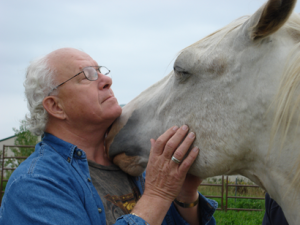This story is about a couple of ways to manage fear that came to me while I was on a white water rafting trip in Costa Rica with my son, Michael. These ideas have been applicable on a number of occasions when I’ve been “stuck” because of fear or overwhelm. Here’s what happened.
Michael had just graduated from college and it was an opportunity for a father and son bonding experience. One challenging thing about the experience for me was that when I was Michael’s age I had been tossed out of a canoe trying to shoot white-water rapids in Minnesota and had a life-threatening experience.
Once I was out of the canoe the river kept tumbling me over and over and pulling me under giving me only seconds to capture a breath. The experience was still very real to me and I never forgot how fortunate I felt to survive the river’s forceful pull. Even though I had recently been on an Outward Bound experience and had learned the difference between “real” fear and “imagined” fear, the idea of shooting rapids in a raft, in a strange country, for nine days, was causing distress for me.
The first day went rather smoothly. We floated down the river and over some rapids but nothing too difficult.
O n the second day of our experience on the General River we came upon a huge wave called Chachalaca. We made a left turn in the river and there it was….a huge, monstrous wave (at least to me) that was 18 feet high and 23 feet in circumference. It curled over like a huge surfing wave. We were told that rafts without enough momentum to get over the top of the wave would be flipped over and people would be popped out of the raft into the heart of the wave.
n the second day of our experience on the General River we came upon a huge wave called Chachalaca. We made a left turn in the river and there it was….a huge, monstrous wave (at least to me) that was 18 feet high and 23 feet in circumference. It curled over like a huge surfing wave. We were told that rafts without enough momentum to get over the top of the wave would be flipped over and people would be popped out of the raft into the heart of the wave.
As luck would have it, we were not able to create enough momentum paddling our raft and everyone in the raft was tossed out of the raft into the river like little toothpicks. When I came up I was underneath the floor of the raft, white air bubbles all around me, but no air to breath. Initially I was calm and struggled to hold onto my sandals. In a moment I decided that it was better to let my sandals go and get to the end of the raft where I could breathe. It seemed like it took forever and fear started to creep in. It felt like that time, back in Minnesota, when white-water rapids were forcefully pulling me under the water and I knew my life was in jeopardy.
Eventually I got outside the raft and was rescued by a kayaker that took me safely to shore. For me it was quite an arresting experience so I sat quietly on the bank while a couple of other rafting groups tried to go back and surf the wave. My experience with shooting the rapids once was enough for me that day and I was okay to just paddle the raft to our next site.
 On the next day of rafting the very first rapid we hit flipped me out, only this time I bumped my knee hard on a rock. After I got back into the raft I began to ponder my situation. I was safe now but what was coming up next? I had been told that further down the river there were some class IV and class V (life threatening) rapids. I was beginning to get pretty anxious about the whole experience.
On the next day of rafting the very first rapid we hit flipped me out, only this time I bumped my knee hard on a rock. After I got back into the raft I began to ponder my situation. I was safe now but what was coming up next? I had been told that further down the river there were some class IV and class V (life threatening) rapids. I was beginning to get pretty anxious about the whole experience.
At the time I didn’t think my options were great. I could walk out…through the jungle, or I could continue to paddle and ride out the river. What had I gotten my son and myself into?
Fortunately for me the trip was populated with several experienced river guides from North America who came to Costa Rica to experience white water rafting in the winter. The river rapids were good (from their perspective) and the water was 30 degrees warmer than in the States. They were happy campers but my son and I were getting quite stressed worrying about the rest of the trip.
In my “landlover” life I had learned to ask for help if I was afraid or stuck…so I thought, perhaps, this was no different if I could swallow my pride. I figured that the experienced river guides had dealt with a rafter’s fear before, so I decided to ask them for ideas on how to tackle my fear. Why not check out my fear to see how I might manage it more effectively?
The first river guide shared that, in his experience, people who became fearful after being tossed out of the raft began projecting the upcoming rapids and in their mind stacked one rapid on top of another. This meant that they envisioned having one huge rapid to go over rather than each individual rapid. His suggestion to me was to take one rapid at a time. That made sense so I relaxed a little bit and went to talk with the second river guide.
The second guide listened to my question, thought about it for a while, and then told me, in a way, I was much safer in the raft than on the river bank. He said there have actually been more injuries with people playing volleyball, badminton, or catch on the river bank than there have been people injured while rafting. He also thought that people would be quite safe if they followed the safety rules of not trying to stand up in the river and remembering to float down the river feet first. The intent is to avoid getting a foot lodged between the rocks and the water’s force bending you over and breaking your leg, or causing you to drown.
That was good advice also. Basically I was pretty safe if I followed the rules and didn’t do things that could cause major injury.
When I talked to the third River guide his comment was “You’re here to have fun and play. Yes, there is a risk of going in the river, but that’s the fun of it. Trying not to be tossed out of the raft is the game, but being tossed into the river isn’t so bad”. He suggested that when the river was smooth I jump off the raft and enjoy the river. Feel the warmth of the water. Play a little in the water so that when I’m tossed out going through the rapids (and there was a pretty good chance that I might be again) it wouldn’t feel so strange or fearful.
I thought that was an interesting aspect. Here I was being afraid of water, something I was very comfortable with since I had been a competitive swimmer for the University of Minnesota. So what I was really afraid of was being dumped out of the raft going through a rapid. Of course, there was always the possibility of hitting the rocks, but I did have a helmet, and there were always safety kayakers around to pull me out if I did get ejected.
So on this trip I learned three great lessons on how to deal with FEAR.
One: Take one rapid at a time.
Two: Follow the safety rules.
Three: Relax and have fun.
Many times when I’m looking at situations where I’m struggling with fear, like writing this article for example, I remember the importance of taking one rapid at time. I need to be careful and not project my fears onto completing the “whole” project. It’s important to break the experience down into stages that I can handle. Then I tell myself that if I follow the rules I’ll be pretty safe in the process and there are always people I can go to that can help me. And,….remember to have fun and enjoy the experience. Keep breathing.
My questions to you are:
What huge fear have you created as a result of adding all the barriers together?
- How can you get yourself unstuck so that you can take action and have fun creating the result you desire?
- Who can you use to rescue (save, help) you if for some reason you should falter?
To learn more about Larry’s offers the next place to go is Services.




